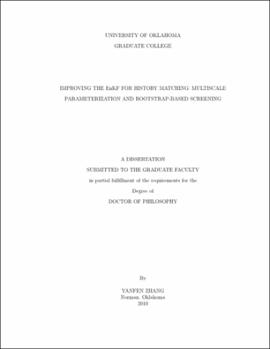| dc.contributor.advisor | Oliver, Dean S | |
| dc.creator | Zhang, Yanfen | |
| dc.date.accessioned | 2019-04-27T21:39:10Z | |
| dc.date.available | 2019-04-27T21:39:10Z | |
| dc.date.issued | 2010 | |
| dc.identifier | 9953386102042 | |
| dc.identifier.uri | https://hdl.handle.net/11244/319265 | |
| dc.description.abstract | Although the ensemble Kalman filter (EnKF) has been remarkably successful for history matching and quantifying uncertainty in petroleum reservoirs, there have been problems with the use of small ensembles, and occasionally with applications to real reservoirs. | |
| dc.description.abstract | Geological complexity and limited access to the subsurface typically result in a large uncertainty in reservoir properties and forecasts. There is, however, a systematic tendency to underestimate such uncertainty, especially when rock properties are modeled using Gaussian random fields. In this dissertation, the uncertainties in multiscale reservoir parameters are quantified through a stochastic multiscale model. The multiscale parameters including regional trend coefficients and heterogeneities can be estimated using the EnKF for history matching. | |
| dc.description.abstract | The proposed method of EnKF with multiscale parameterization was tested on a deepwater field whose reservoir model has over 200,000 unknown parameters. The match of reservoir simulator forecasts to real field data using a standard application of EnKF had not been entirely satisfactory, as it was difficult to match water cut in a main producer of PFJ2 reservoir. None of the realizations of the reservoir exhibited water breakthrough using the standard method. By adding uncertainty in large scale trends of reservoir properties, the ability to match the water cut and other production data was improved substantially. The results indicate that an improvement in the generation of the initial ensemble and in the variables describing the property fields give an improved history match with plausible geology. The multiscale parameterization of property fields reduces the tendency to underestimate uncertainty while still providing reservoir models that match data. | |
| dc.description.abstract | Another aspect that this dissertation focuses on is statistical sampling error caused by a limited ensemble size. The number of ensemble members (ensemble size) is critical to the efficiency and performance of the EnKF. When the ensemble size is small, the Kalman gain generally can not be well estimated. The most common approach for reducing the effect of spurious correlations on model updates is multiplication of the estimated covariance or Kalman gain by a tapering function that eliminates all correlations beyond a prespecified distance. The distance-based localization, however, is not always appropriate. In the dissertation, we propose a more general method for regularizing Kalman gain, which discriminates between the real and the spurious correlations in the Kalman gain matrix by using the bootstrap resampling technique to assess the confidence level of each element from the Kalman gain matrix. | |
| dc.description.abstract | Both the bootstrap-based screening and the commonly used distance-based localization are type of regularization methods, but use different mechanisms. The concept of distance-based localization was originally applied to the covariance matrix. Improved results, however, were also obtained by applying localization on the Kalman gain. In spite of the widespread applications of these two ways of using localization, little in the literature addresses the difference between these two ways of applying localization. This dissertation presents a comparison between the covariance regularization and the Kalman gain regularization in three aspects: improvement observed in the estimates of the Kalman gain, quality of data prediction, and the estimates of model variables. Two regularization methods are taken into consideration including the distance-dependent localization and the bootstrap-based screening. The investigation resulted in three primary conclusions. First, if localizations of two covariance matrices are not consistent, the estimate of the Kalman gain will generally be poor at the observation location. The consistency condition can be difficult to apply for nonlocal observations. Second, the estimate of the Kalman gain that results from covariance regularization is generally subject to greater errors than the estimate of the Kalman gain that results from Kalman gain regularization. Third, in terms of removing spurious correlations in the estimation of spatially correlated variables, the performance of screening Kalman gain is comparable as the performance of localization methods (applied on either covariance or Kalman gain), but screening Kalman gain outperforms the localization methods in terms of generality for application, as the screening method can be used for estimating both spatially correlated and uncorrelated variables, and moreover, no assumption about the prior covariance is required for screening method. | |
| dc.format.extent | 131 pages | |
| dc.format.medium | application.pdf | |
| dc.language | en_US | |
| dc.relation.requires | Adobe Acrobat Reader | |
| dc.subject | Kalman filtering | |
| dc.subject | Oil reservoir engineering--Mathematical models | |
| dc.subject | Geological modeling | |
| dc.subject | Petroleum reserves--Mathematical models | |
| dc.title | IMPROVING THE EnKF FOR HISTORY MATCHING: MULTISCALE PARAMETERIZATION AND BOOTSTRAP-BASED SCREENING | |
| dc.type | text | |
| dc.type | document | |
| dc.thesis.degree | Ph.D. | |
| ou.group | Mewbourne College of Earth and Energy::Mewbourne School of Petroleum and Geological Engineering | |
